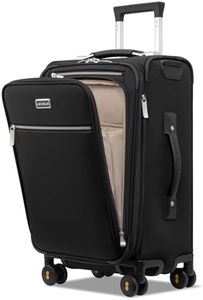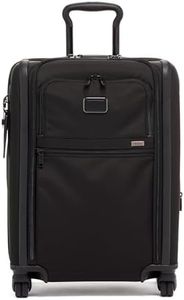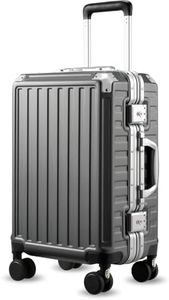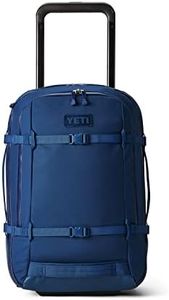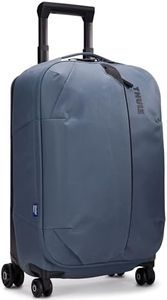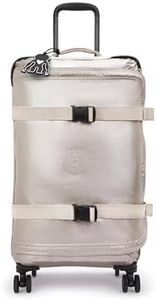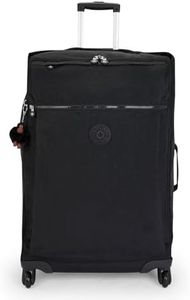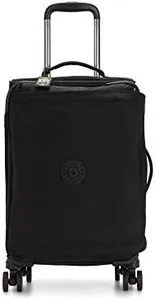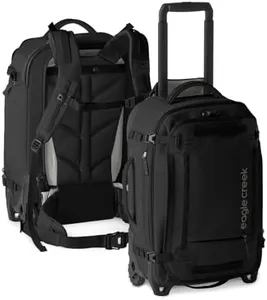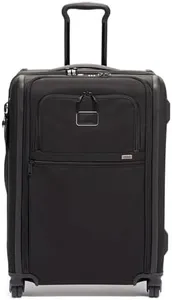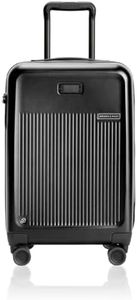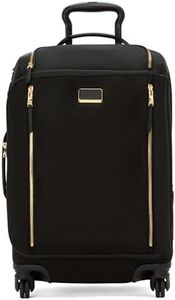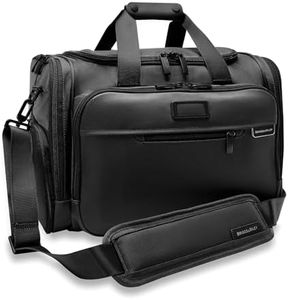10 Best Carry On Luggage 2025 in the United States
Our technology thoroughly searches through the online shopping world, reviewing hundreds of sites. We then process and analyze this information, updating in real-time to bring you the latest top-rated products. This way, you always get the best and most current options available.

Our Top Picks
Winner
TUMI Alpha Continental Dual Access 4-Wheeled Carry-on Luggage - Rolling, Lightweight Suitcase - Secure Suitcase with Lock - Black
Most important from
72 reviews
The TUMI Alpha Continental Dual Access carry-on is designed for travelers who want a premium, functional suitcase. Its size fits standard airline carry-on limits well, with dimensions around 22 x 16 x 9 inches, making it a good fit for overhead bins. Weighing nearly 12 pounds, it is on the heavier side for carry-ons, which might be a consideration if you prefer ultra-light luggage. Durability is a strong point here, with protective bumper rails and a construction aimed at withstanding frequent travel wear and tear. The 4-wheel setup combined with the advanced X-Brace 45 handle system allows smooth, multi-directional rolling, making it easy to maneuver crowded airports or tight spaces.
In terms of organization, the dual-access front lid and split-case design provide flexible packing options and quick access to essentials without opening the entire suitcase. The smart compartments and a hanging mesh pocket with a USB-C charging port add convenience, especially for tech-savvy users who need to charge devices while on the move. Security is well addressed through a built-in TSA combination lock, ensuring your belongings stay protected without causing delays at airport security.
The suitcase carries a five-year warranty, reflecting confidence in its build quality. Style-wise, the sleek black finish presents a professional and timeless look suitable for both business and leisure travel. The weight and lack of explicit expandability may be drawbacks for some. Travelers who value durability, organization, and security over ultralight packing will find this luggage particularly suitable.
Most important from
72 reviews
Carry On Luggage with Spinner Wheels, 8010S Aluminum Frame Zipperless Polycarbonate Hard Shell Suitcase (ZX-Core, Charcoal Metallic, 20 Inch)
Most important from
744 reviews
The LUGGEX Aluminum Frame Luggage is a sturdy and stylish 20-inch carry-on featuring a zipperless design and TSA-approved latches, which help make airport security checks quicker and easier. Its hard polycarbonate shell reinforced with an aluminum frame and corner protectors offers strong durability and protection for your belongings, making it ideal for frequent travelers concerned about rough handling.
The spinner wheels include built-in springs to reduce vibrations and provide a smooth, stable roll on various surfaces, easing the strain of pulling the bag. Weighing 8.6 pounds, the suitcase supports its solid build. Inside, it offers 36 liters of space, sufficient for a short trip. The security lock is designed to prevent accidental openings, providing extra peace of mind.
With a charcoal metallic finish, the luggage has a modern and professional look suitable for most travelers. This LUGGEX carry-on is a reliable choice for those who prioritize durability, smooth mobility, and hassle-free security features.
Most important from
744 reviews
YETI Crossroads Luggage, 22 inch Carry-On, Navy
Most important from
201 reviews
The YETI Crossroads 22 inch Carry-On in Navy is designed for the traveler who needs a durable and reliable bag. Made from TuffSkin Nylon, it's built to endure rough handling and exposure to dirt and grime, making it a good choice for frequent travelers who find themselves in various environments.
The luggage measures 22” x 14“ x 9” and has a weight of 7.54 lbs, which is relatively heavy for a carry-on, potentially reducing your packing weight allowance. However, its 40-liter capacity offers ample space for your belongings, and the removable Modular Compression Straps help you compress and organize your items efficiently, both internally and externally. The Interior Pocket Divider Panel is a useful feature to keep your items organized and easily accessible.
While the product's durability and organizational features are strong points, the luggage's weight might be a consideration for those who prefer lighter options. Additionally, it does not mention specific security features, which might be a drawback for some users. The style and aesthetics of the YETI Crossroads are modern and appealing. This carry-on is likely best suited for travelers who prioritize durability and organization over lightweight options.
Most important from
201 reviews
Buying Guide for the Best Carry On Luggage
Choosing the right carry-on luggage can make your travel experience much smoother and more enjoyable. The key is to find a balance between size, weight, durability, and functionality that suits your specific travel needs. Here are some important specifications to consider when selecting carry-on luggage, along with explanations to help you make an informed decision.FAQ
Most Popular Categories Right Now
